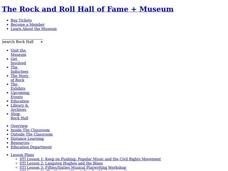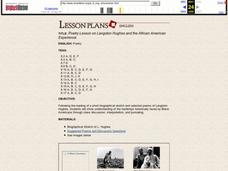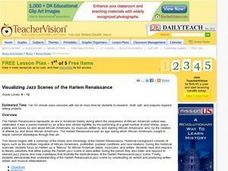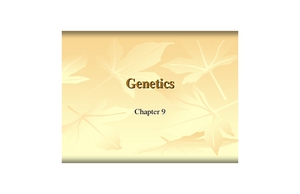Curated OER
Langston Hughes and the Blues
Students explore the connections between Langson Hughes and blues music. In this African American culture instructional activity, students compare and contrast blues music with poetry and short stories by Langston Hughes.
Curated OER
POETRY LESSON ON LANGSTON HUGHES AND THE AFRICAN AMERICAN EXPERIENCE
Eighth graders read the short biographical sketch and selected poems of Langston Hughes, 8th graders examine the hardships historically faced by Black Americans through class discussion, interpretation, and journaling.
Curated OER
"Thank You Ma'am" by Langston Hughes
Students use Langston Hughes' "Thank You Ma'am" as a reading and vocabulary improvement activity. In this reading and vocabulary lesson, students review the related vocabulary and read the poem. Students discuss the story elements in the...
Curated OER
Langston Hughes: Artist and Historian
High schoolers examine the life and works of Langston Hughes. In groups, they research the characteristics of the Harlem Renaissance and how Hughes' poems relate to the era. They use the themes in his writings and relate it to the...
National Endowment for the Humanities
A Raisin in the Sun: Whose "American Dream"?
How does Lorraine Hansberry's A Raisin in the Sun factor into a discussion of the American dream? High schoolers define the American dream and recognize the historical setting of the play. Additionally, they identify forms of...
Curated OER
Maniac McGee
Students read and analyze the novel, Maniac McGee. They answer discussion questions, read the short story "Thank You, M'am," by Langston Hughes, and conduct Internet research on genealogical websites to analyze their first and last names.
Curated OER
The Harlem Renaissance Births a Black Culture
Students examine the men and women who were a part of the Harlem Renaissance. Individually, they recreate their favorite pieces of art from the time period and create their own original works after reading poem from the movement. In...
Orange County Department of Education
Integrity and "Thank You, M'am"
Ninth graders explore the definition of integrity through a class discussion. They provide positive/negative examples from the story and their own experiences. Students determine character traits by analyzing the dialogue in a short...
Curated OER
Six Trait Writing with Twain and Doyle
Students explore the traits of writing in this six lessons unit. Poems, fiction, and drama are evaluated to identify writing strategies. Utilization of vocabulary and writing rubrics help students judge the effectiveness of their own...
Curated OER
Harlem Renaissance: Pivotal Period in the Development of Afro-American Culture
Students examine the time period of the Harlem Renaissance. In groups, they compare and contrast the type of art before and after the movement along with the state of society at the time. After reading a book on the topic of their...
Curated OER
Jazz Scenes of the Harlem Renaissance
Students identify and connect themes of selected nonfiction, fiction, poetry, and art to Harlem Renaissance jazz. They compare and contrast historical and fictionalized versions of the jazz scenes of the Harlem Renaissance. They...
Curated OER
Directed Reading Thinking Activity: "A Raisin in the Sun"
Students predict outcomes of a text. In this comprehension strategy lesson, students read a poem and compare it to the play A Raisin in the Sun. Students discuss their similarities and the power of dreams.
Curated OER
Genetics
Students identify literary elements in each selection while learning about diversity and the struggle for equality in the United States. They use their knowledge to express the emotion and key literary elements in each piece through...














